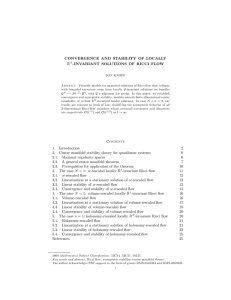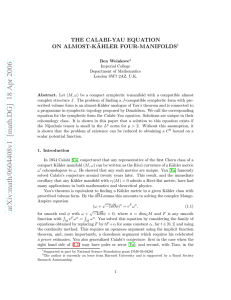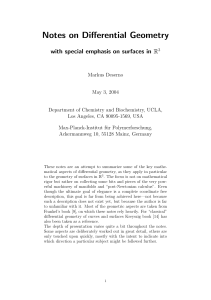Lecture 7 - Topics
advertisement
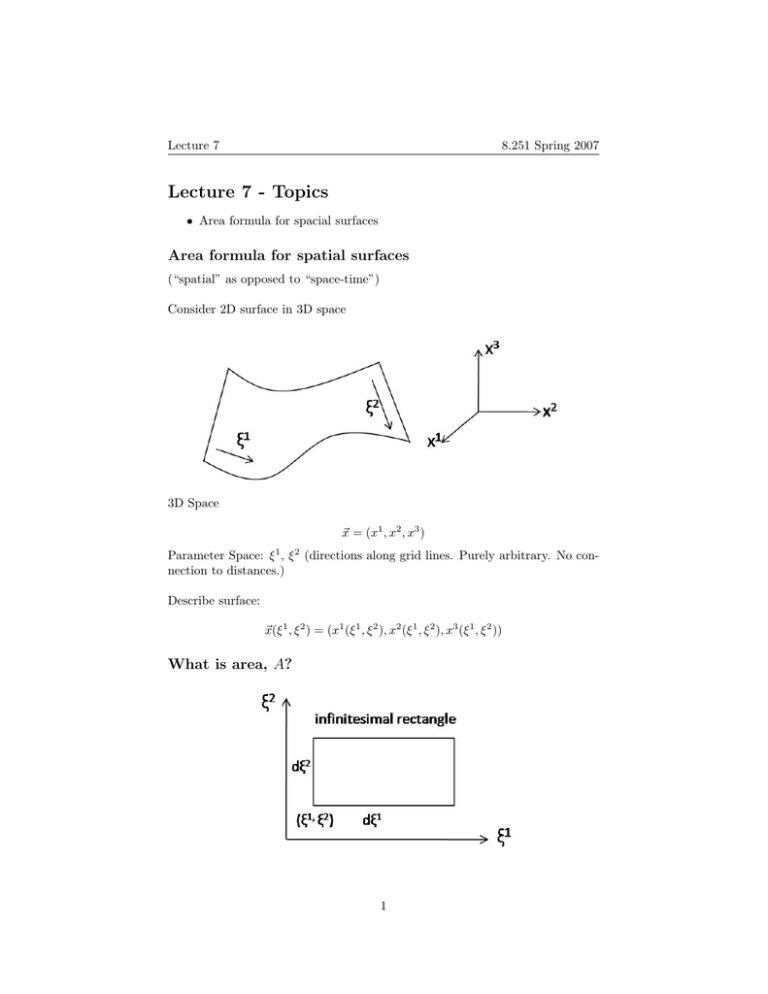
Lecture 7 8.251 Spring 2007 Lecture 7 - Topics • Area formula for spacial surfaces Area formula for spatial surfaces (“spatial” as opposed to “space-time”) Consider 2D surface in 3D space 3D Space �x = (x1 , x2 , x3 ) Parameter Space: ξ 1 , ξ 2 (directions along grid lines. Purely arbitrary. No con­ nection to distances.) Describe surface: �x(ξ 1 , ξ 2 ) = (x1 (ξ 1 , ξ 2 ), x2 (ξ 1 , ξ 2 ), x3 (ξ 1 , ξ 2 )) What is area, A? 1 Lecture 7 8.251 Spring 2007 � A= infinitesimal rectangles ξ1 ,ξ2 Map to surfae: d�v1 : infinitesimal vector corresponding to dξ 1 on ξ1 To linear order, these 1, 2, 3, 4 points form a parallelogram ∂� x (ξ 1 , ξ 2 )dξ 1 ∂ξ�1 ∂� x (ξ 1 , ξ 2 )dξ 2 ∂ξ�2 d�v1 : Mapping of bottom line of rectangle = d�v2 : Mapping of left line of rectangle = dA = base · height = |d�v1 | · |d�v2 | sin θ � = |dv1 |2 |dv2 |2 − (d�v1 · d�v 2 )2 �� �� � � �2 ∂�x ∂�x ∂�x ∂�x ∂�x ∂�x 1 2 = dξ dξ · · − · ∂ξ 1 ∂ξ 2 ∂ξ 2 ∂ξ 2 ∂ξ 1 ∂ξ 2 2 Lecture 7 8.251 Spring 2007 � A= dA Important that this formula is reparameterization-invariant. Reparam. Invariance Choose another coordinate par. (ξ�1 , ξ�2 ). Can write as functions of our (ξ 1 , ξ 2 ) coordinates. Must have: �� �� � � �2 � ∂�x ∂�x ∂�x ∂�x ∂�x ∂�x � � 1 2 dA = dξ dξ · · − · ∂ξ�1 ∂ξ�2 ∂ξ�2 ∂ξ�2 ∂ξ�1 ∂ξ�2 Metric d�x = ∂�x 1 ∂�x dξ + 2 dξ 2 = ∂ξ 1 ∂ξ ∂�x i dξ ∂ξi � �� � implicit sum i=1,2 ds2 = |d�x|2 = d�x · d�x = ∂�x ∂�x ∂ξ i ∂ξ j � �� � dξ i dξ j This is the metric. 1 2 1 = gij (ξ , ξ )dξ dξ Where metric gij = 2 ∂� x ∂� x ∂ξ i ∂ξ j Called the “induced metric” (induced because metric not made up but rather determined/inherited from the metric in the space the surface was embedded in). � � ∂� x ∂� x ∂� x ∂� x ∂ξ 1 · ∂ξ 1 ∂ξ 2 · ∂ξ 1 gij = ∂� x ∂� x ∂� x ∂� x ∂ξ 1 · ∂ξ 2 ∂ξ 2 · ∂ξ 2 3 Lecture 7 8.251 Spring 2007 � A= √ dξ 1 dξ 2 g where g = det(gij ) 4



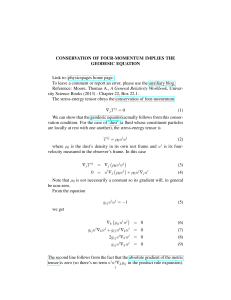
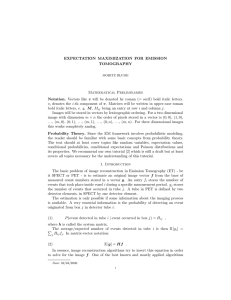
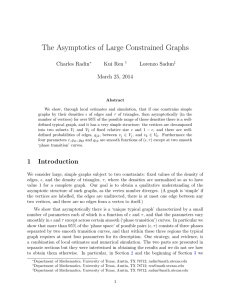
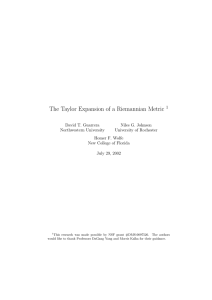
![arXiv:1509.02685v3 [gr-qc] 18 Dec 2015](http://s2.studylib.net/store/data/018910517_1-3c883724886d98d7a69c60e3bb3e3c1a-300x300.png)
